Art Nouveau: mischer'traxler reveal Perrier-Jouët collaboration for LDF
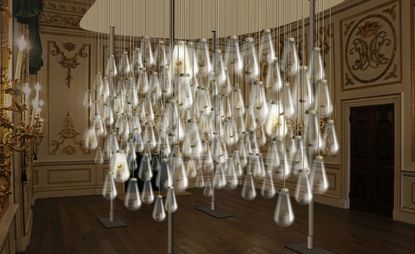
Last year, Perrier-Jouët enlisted Austrian creative duo mischer’traxler to create an immersive installation at Design Miami/ (see Wallpaper* 189). With Ephemera, the pair looked at plants and flowers, recreating their silhouettes on a tabletop and bringing them to life with vibrantly stained veneer. The creatures – which 'grew' from the table’s surface – would flatten down when someone approached them; a poetic interpretation of the relationship between humans and nature.
‘When Perrier-Jouët approached us to develop a new project, we thought it would be nicer and more logic[al] not to tell a completely new story, but to continue the story we started with Ephemera,’ explains Katharina Mischer. Their new work, Curiosity Cloud, will debut at this September's London Design Festival, in the Victoria and Albert Museum’s grandiose Norfolk Hall Music Room.
250 hand-blown glass vessels (produced by Lobmeyr in collaboration with the designers) will hang from the room’s ceiling, each housing a reproduction of an insect which will react to movement by flying inside the glass globes, producing light and sound.
‘We wanted to show the species in an alive way and reacting to the audience,’ explains Mischer's colleague and studio co-Founder Thomas Traxler. ‘We think it is important to see humans as part of our surrounding nature and not excluded from it like an observer. We are part of it, we have an impact. In Curiousity Cloud [we see] some sort of chaos and impulse we bring into a set surrounding. The swarm of insects reacts nervously but beautifully at the same time.’
In preparation for the project, the duo engaged in an intensive period of research into the natural world, looking at common species such as bees, butterflies and fireflies, as well as extinct and newly-discovered insects from Asia and South America. In total, Curiosity Cloud features 25 species of common, rare and new insects, all selected following an aesthetic criteria. ‘We prefer real insects since it does not make any sense to us to come up with our own fantasy insects if the real world is full of fascinating little creatures anyway. We think there is an importance to point that out,' the designers explain. ‘Referring to reality means [creating] a closer connection to the natural world and to highlight it.’ The fantasy element, they concede, is derived from the fact that those species come from such disparate geographic locations and environments.
To create the creatures, the pair printed wing patterns onto transparent foil and then laser-cut them for precision, before attaching them to bodies and antennae made of felt, nylon and different threads. Each insect is then affixed to the inside of its globe with a thin wire, allowing an emulation of natural movement. The pair worked closely with Lobmeyr to develop the glass parts, and with Viennese metal-spinning company Wilhelm Seidl to engineer the movement at the top of each jar.
The installation will mark a further step in the year-long collaboration between mischer’traxler and Perrier-Jouët, revealing a new chapter in the champagne house’s celebration of Art Nouveau’s organic forms and natural expressions.
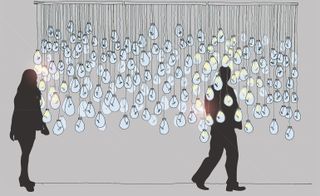
The installation will feature 250 hand-blown glass vessels hanging from the room’s ceiling, each housing a reproduction of an insect that will react to movement by flying inside the glass globes, producing light and sound
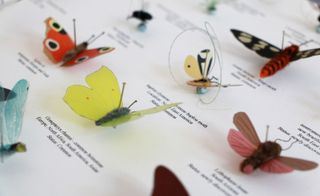
The pair have researched the natural world extensively, looking at common species such as bees, butterflies and fireflies, but also extinct and newly-discovered insects from all over the globe

In total, Curiosity Cloud features 25 species divided between common, rare and new insects, all selected following aesthetic criteria
![‘Referring to reality means [creating] a closer connection to the natural world and to highlight it.](https://cdn.mos.cms.futurecdn.net/cdrrQgtRmFb73SxSogRKEa-320-80.jpg)
‘We prefer real insects since it does not make any sense to us to come up with our own fantasy insects if the real world is full of fascinating little creatures anyway. We think there is an importance to point that out,' the designers explain
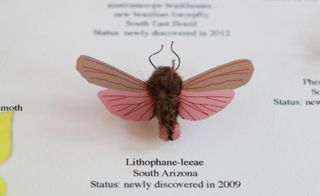
To create the creatures, the pair printed wing patterns onto transparent foil and then laser-cut them for precision, before attaching them to bodies and antennae made of felt, nylon and different threads

Each insect is then affixed to the inside of its globe with a thin wire, allowing an emulation of natural movement

A moodboard of the designers' research
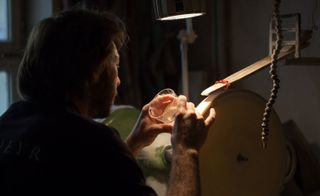
The pair worked closely with Lobmeyr to develop the glass parts, which were hand-blown in the company's Austrian headquarters

'We always try to work with local craftsman and companies. Some of them are really incredible and still in the middle of the city – we want it to stay like that, so we want to work with them,' they duo explained

Viennese metal-spinning company Wilhelm Seidl engineered the movement at the top of each jar
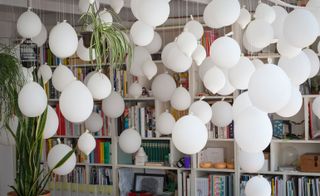
A mock-up of the installation at the designers' studio in Vienna
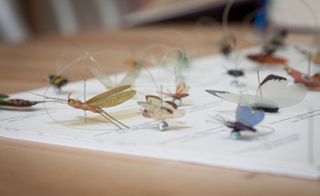
On using real insects for inspiration, the duo says that ‘referring to reality means to us to create a closer connection to the natural world and to highlight it’. The fantasy element, they concede, is derived from the fact that those species come from such disparate geographic locations and environments
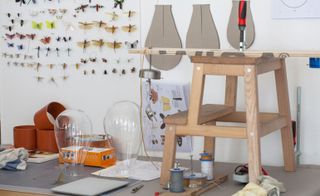
The installation will mark a further step in the year-long collaboration between mischer’traxler and Perrier-Jouët, which started with last year's Ephemera project, shown at Design Miami/

‘When Perrier-Jouët approached us to develop a new project, we thought it would be nicer and more logic[al] not to tell a completely new story, but to continue the story we started with Ephemera,’ explains Katharina Mischer
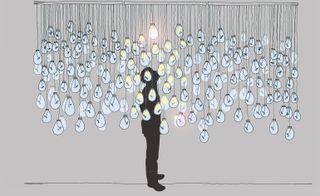
‘We think it is important to see humans as part of our surrounding nature and not excluded from it like an observer,' says Thomas Traxler. 'We are part of it, we have an impact. In Curiousity Cloud [we see] some sort of chaos and impulse we bring into a set surrounding. The swarm of insects reacts nervously but beautifully at the same time’
ADDRESS
Victoria and Albert Museum
Cromwell Road
London, SW7 2RL
Wallpaper* Newsletter
Receive our daily digest of inspiration, escapism and design stories from around the world direct to your inbox
Rosa Bertoli was born in Udine, Italy, and now lives in London. Since 2014, she has been the Design Editor of Wallpaper*, where she oversees design content for the print and online editions, as well as special editorial projects. Through her role at Wallpaper*, she has written extensively about all areas of design. Rosa has been speaker and moderator for various design talks and conferences including London Craft Week, Maison & Objet, The Italian Cultural Institute (London), Clippings, Zaha Hadid Design, Kartell and Frieze Art Fair. Rosa has been on judging panels for the Chart Architecture Award, the Dutch Design Awards and the DesignGuild Marks. She has written for numerous English and Italian language publications, and worked as a content and communication consultant for fashion and design brands.
-
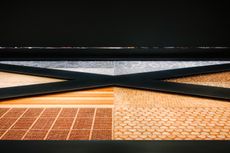 Hermès celebrates the materiality of earth in theatrical Milan Design Week 2024 spectacle
Hermès celebrates the materiality of earth in theatrical Milan Design Week 2024 spectacleThe Topography of Material is Hermès Milan Design Week 2024 display at La Pelota, focused on an installation exploring the materiality of earth and celebrating new and archival objects
By Rosa Bertoli Published
-
 Elias Sime reflects on the destructive nature of technology in Venice
Elias Sime reflects on the destructive nature of technology in VeniceIn his solo show ‘Elias Sime: Dichotomy ፊት አና ጀርባ’ at the Venice Biennale 2024, the artist spotlights technology's destructive nature for humans and the environment
By Gameli Hamelo Published
-
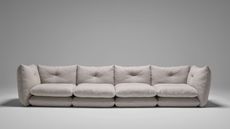 Knoll presents Willo Perron sofa at Salone del Mobile 2024, 'a piece that can stay with you forever'
Knoll presents Willo Perron sofa at Salone del Mobile 2024, 'a piece that can stay with you forever'Salone del Mobile 2024: the ‘Pillo’ sofa by Willo Perron for Knoll is the California-based designer’s first piece for the American brand, prioritising comfort and timeless usability
By Rosa Bertoli Published
-
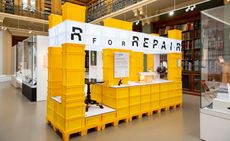 ‘R for Repair’ at London Design Festival displays broken objects, re-formed
‘R for Repair’ at London Design Festival displays broken objects, re-formedIn the second half of a two-part exhibition and as part of London Design Festival 2022, ‘R for Repair’ at the V&A displays broken objects, re-formed
By Martha Elliott Last updated
-
 ‘Finding quality through the act of making’: Pearson Lloyd celebrates 25 years of design
‘Finding quality through the act of making’: Pearson Lloyd celebrates 25 years of designPearson Lloyd’s show ‘Change Making’ reflects on past designs from its archives, showcasing the influences on and evolution of the studio, from furniture design to the NHS
By Martha Elliott Last updated
-
 Tom Dixon marks his studio's 20 years with a show of design experiments
Tom Dixon marks his studio's 20 years with a show of design experimentsMushroom, cork, steel coral and more: Tom Dixon showcases an overview of his design experiments as he celebrates his practice's 20 years
By Rosa Bertoli Last updated
-
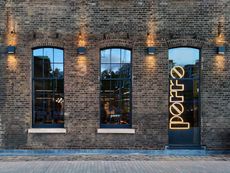 Porro unveils new London showroom at Coal Office
Porro unveils new London showroom at Coal OfficeLondon Design Festival 2022: industrial architecture meets pure geometries in the new Porro showroom, taking over a space within Tom Dixon’s Coal Office to showcase the brand’s systems and furniture
By Rosa Bertoli Last updated
-
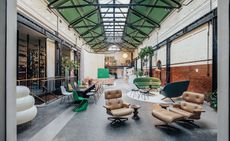 Vitra unveils new London home in the Tramshed, Shoreditch
Vitra unveils new London home in the Tramshed, ShoreditchLondon Design Festival 2022: after a year-long renovation, Vitra opens the door to its new showroom in the heart of Shoreditch
By Rosa Bertoli Last updated
-
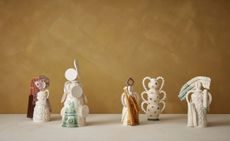 Mudlarking beside the River Thames inspires The New Craftsmen’s makers
Mudlarking beside the River Thames inspires The New Craftsmen’s makersLondon Design Festival 2022: The New Craftsmen’s new collection, ‘Claylarks’, features work from a group of creatives inspired by a River Thames mudlarking expedition
By Mary Cleary Last updated
-
 One tree, ten designers: SCP presents The One Tree Project at London Design Festival
One tree, ten designers: SCP presents The One Tree Project at London Design FestivalLondon Design Festival 2022: SCP enlisted ten British designers to create furniture and objects from a felled ash tree from founder Sheridan Coakley's Hampshire garden
By Francesca Perry Last updated
-
 London Design Medals 2022
London Design Medals 2022London Design Medals 2022 are awarded to costume designer Sandy Powell, architect Indy Johar, researcher Joycelyn Longdon and photographer Sir Don McCullin
By Rosa Bertoli Last updated